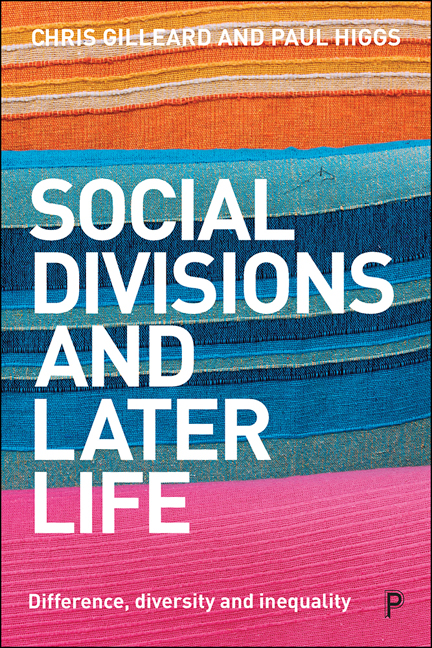Book contents
- Frontmatter
- Contents
- List of Figures and Tables
- Preface
- 1 Social Divisions and Social Differences
- 2 Social Class and Inequality in Later Life
- 3 Ageing and Gender
- 4 Ethnicity, Race and Migration in Later Life
- 5 Disability and Later Life
- 6 Identity and Intersectionality
- 7 Diversity, Difference and Division in Later Life
- References
- Index
4 - Ethnicity, Race and Migration in Later Life
Published online by Cambridge University Press: 25 February 2021
- Frontmatter
- Contents
- List of Figures and Tables
- Preface
- 1 Social Divisions and Social Differences
- 2 Social Class and Inequality in Later Life
- 3 Ageing and Gender
- 4 Ethnicity, Race and Migration in Later Life
- 5 Disability and Later Life
- 6 Identity and Intersectionality
- 7 Diversity, Difference and Division in Later Life
- References
- Index
Summary
Ethnicity and race have become increasingly salient categories of social division for both policy makers and researchers in contemporary society (Bottero, 2004). As regards their social location in later life, however, they remain more or less marginal to the immediate issues they present to social integration and social conflict in the wider society (Torres, 2019a). The presence of ethnic minorities is itself seen through the lens of migration, whether as the consequence of historical processes of de-colonisation or of contemporary global unrest and upheaval. This is so particularly in the European context, while in North America ethnicity and race have rather different meanings and points of reference. In contrast to ethnicity which, at least until recently, has been refracted through migration and the self-narrative of its modern emergence, in the USA race is more surely located as a pervasive divide cutting through society. Their exclusion from full participation in the economy, which continued, albeit in more diluted form, well into the twentieth century, has placed African Americans as a group apart, distinct from the position of other ethnic groups whose members have often been seen as those who ‘built’ society. These divergent histories are crucial in trying to understand the nature of ethnic and racial divides as well as the accompanying experiences within Europe and America and their various realisations in later life. While they bring new meanings and interpretations to the concerns of old age, they do so in different ways, and through different historical trajectories in each of the two continents. In this sense, the divisions of race and ethnicity are themselves mediated by and intersect with the circumstances and experiences of age and agedness.
Before discussing the social divisions of ethnicity and race in relation to their specific realisations in later life, we should first consider what is being described by these linked but separable terms. Discussing how the modern state has sought to establish an appropriate organisation of ethnicity, race and migration, Ludi Simpson has made the following observation:
In the UK, the motivation for government measurement of ‘ethnic group’ can be traced to aims of anti-discrimination, multi-culturalism, controlling immigration, and social cohesion, each of which demands different categories and analyses.
- Type
- Chapter
- Information
- Social Divisions and Later LifeDifference, Diversity and Inequality, pp. 69 - 94Publisher: Bristol University PressPrint publication year: 2020



